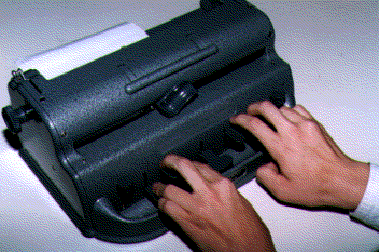Session 2: Braille Writing Devices -- Perkins Brailler
The Perkins brailler:

is by far the most efficient device for producing braille "by hand" (i.e., not generated by computer). The Perkins brailler has nine keys: the six keys corresponding to the six dots, a space bar, a backspace key, and a paper advance/line feed key. In addition, it has a thumb-lever to move the typing head back to the beginning of a line. Dots are made by pressing one or more keys simultaneously, following this pattern:
- Dot 1: index finger of left hand
- Dot 2: middle finger of left hand
- Dot 3: ring finger of left hand
- Dot 4: index finger of right hand
- Dot 5: middle finger of right hand
- Dot 6: ring finger of right hand
The space bar, in between the six keys, is pressed with either the left or the right-hand thumb. The backspace key is on the far right, and the paper advance key is on the far left.
To load paper, follow these instructions:
- turn the paper knob (on either side of the brailler) as far as it go, turning it counterclockwise
- open the print head by pushing the left-most lever (on top of the brailler) all the way forward
- insert the paper until it stops
- close the left-most lever
- press the paper advance key once to set the paper
To remove the paper, simply push the left-most lever forward and remove the paper. You should ensure that the paper is either rolled out FIRST or that you have advanced it all the way to the bottom of the page. Once you have removed the paper, it is difficult, if not impossible, to reinsert it and have the dots line up. Before you remove your paper from the brailler, it is a good idea to proofread your work. Erasures can be made by rolling the paper out slightly and pushing the dots back into the paper, using the metal foundation of the brailler for support.
Braillers have the advantages of being fast, making clean dots, and being easy to use. Cells do not have to be inverted as they are with the slate, and it is easy to read your braille as it comes out of the brailler. The main disadvantage, besides the fact that you can't put it in your pocket, is the expense. Current Perkins braillers run close to $850. Their durability also makes in difficult to find used braillers (I've had mine since the late 1960's, and it works like a charm!). The Perkins brailler is simply a very well engineered writing device.
(If you are using the Mac/PCBraille software, keep in mind that this software program is designed to emulate the feel of a Perkins brailler, with the additional advantage in allowing you to send your assignments to me via email.)
Back to Slate and Stylus
On to Computer-driven Devices
|